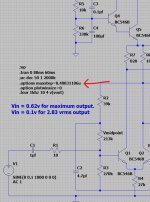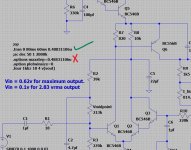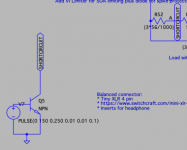Found it: Open the asc file with a Textedit, look for DATAFLAG - change "$" with "round($*100)/100" for 2 digits after the decimal point.I have Ltspice for Mac, looks like that is different with Windows
i would like to change .op Data labels ( i have to many numbers after the dot).
I am not able to find how to do it with Mac..Please help Thanks
To be more exact, edit the plot trace name by enclosing it in d(.......) such as d(V(out)). This gives you a slew waveform plot and you can use a cursor to find the positive and negative peaks. It is common that the positive slew limit is different from the negative slew limit. There is probably also a .measure directive that will find the peaks and report it in the error log. Note that the slew scale will be labeled in MegaVolts/Second, which is the same as V/uS.Simply by using dv(…)
Edit... see next post.
I've noticed something different recently but I'm honestly not sure if its me or LT. I think it must be LT because what worked in the past now does not.
Its the timestep. In the past I could always just add the timestep as a .op command as here. This is an old sim and it runs correctly. The distortion comes out at the expected value. All good.

If I delete that .op statement and then re apply it the distortion is massive and gets worse the longer the sim runs. It took me a while to suss out but now the timestep has to be entered into the 'Transient' sim tab so that it appears as one statement.
So old sims that have the timestep entered as a copy and paste still seem to work OK but if altered they do not, and the timestep has to be re entered onto the Transient tab. I discovered this when simply resaving a circuit under a different name to modify something and the distortion results were really poor. Delete the .op entry for timestep and reapply it via the Transient tab and it all works.

Hope that makes sense 🙂
I've noticed something different recently but I'm honestly not sure if its me or LT. I think it must be LT because what worked in the past now does not.
Its the timestep. In the past I could always just add the timestep as a .op command as here. This is an old sim and it runs correctly. The distortion comes out at the expected value. All good.

If I delete that .op statement and then re apply it the distortion is massive and gets worse the longer the sim runs. It took me a while to suss out but now the timestep has to be entered into the 'Transient' sim tab so that it appears as one statement.
So old sims that have the timestep entered as a copy and paste still seem to work OK but if altered they do not, and the timestep has to be re entered onto the Transient tab. I discovered this when simply resaving a circuit under a different name to modify something and the distortion results were really poor. Delete the .op entry for timestep and reapply it via the Transient tab and it all works.

Hope that makes sense 🙂
Last edited:
^
Just trying all the above again and now its seems to work as expected....
Ignore for now. If the issue occurs again I'll come back with it. Its odd what happened.
Just trying all the above again and now its seems to work as expected....
Ignore for now. If the issue occurs again I'll come back with it. Its odd what happened.
I would like to use a 2SC2275 NPN transistor as a Vbe multiplier but LTSpice does not recognise it. The datasheet is available for download. Could anyone post its ".model" listing? The listing should be as follows below:
Datasheet at: https://futurlec.com/Transistors/2SC2275.shtml
Please note the previousy quoted model 2SC2575 is not available or does not exist.
Code:
.model 2SC2275 NPN( ........ )Datasheet at: https://futurlec.com/Transistors/2SC2275.shtml
Please note the previousy quoted model 2SC2575 is not available or does not exist.
Please note, I am changing transistor with another one that is available and can be simulated on LTSpice. It is a real headache to find the parts. I will simulate with MJE15030 as a VBE multiplier transistor because it is packaged in a TO220 package which can be securely mounted on the back of one of the eight power transistors. I am getting the impression simulations are not as deterministic in this, it seems the sure way is to install the MJE15030, find an approximate but good bias and then proceed to compensate for temperature changes. The setup has to be done experimentally as this is the only way which provides some reliability. The voltage margin is too small for calculations and simulations to be very predictable.
Calculations and simulations have shown using this rather expensive transistor does not provide any advantage over other less expensive transistors. Contrary to what I expected from a more expensive device, temperature tracking is less effective with quiescent currents which can easily give rise to low amplitude self oscillations.
I will have to be contented with a BD135 transistor as it provided the best bias stability versus temperature. My next calculations will now focus on a narrower temperature range starting from 10C to 45C.
I will have to be contented with a BD135 transistor as it provided the best bias stability versus temperature. My next calculations will now focus on a narrower temperature range starting from 10C to 45C.
Hello again guys,
I'm not so sure if this is the proper thread to post my query but since it is LTSpice specific, I might as well ask it here.
Has any one of you manage to refine the text on THD windowing under Wine on Linux?
I'm on pure Arch with Mate as the desktop environment. I tried installing and enabling compton (window compositor) but I get the same result. I used to work on Xfce on the lighter/speedier side but screen tearing is terrible especially when scaling windows.
Thanks!

I'm not so sure if this is the proper thread to post my query but since it is LTSpice specific, I might as well ask it here.
Has any one of you manage to refine the text on THD windowing under Wine on Linux?
I'm on pure Arch with Mate as the desktop environment. I tried installing and enabling compton (window compositor) but I get the same result. I used to work on Xfce on the lighter/speedier side but screen tearing is terrible especially when scaling windows.
Thanks!
I would like to have a variable: GAIN.
I have seen a simulation where it was used in a formula.
Here is what I want to use it for: to see the distortion in the output. And be able to quickly change components and see the effect.
I now have determined the gain from the screen (where gain = 3.86) but two decimal accuracy is only found with checking various values sequentially, which costs me some time to manually approximate the real value. [On a distortion meter there is that nice knob 'phase' which is handsome to null the distortion to its lowest point.]

I have seen a simulation where it was used in a formula.
Here is what I want to use it for: to see the distortion in the output. And be able to quickly change components and see the effect.
I now have determined the gain from the screen (where gain = 3.86) but two decimal accuracy is only found with checking various values sequentially, which costs me some time to manually approximate the real value. [On a distortion meter there is that nice knob 'phase' which is handsome to null the distortion to its lowest point.]
Finally fixed it! By following the instructions at Wine-ArchWicki and installing ms-fonts via extraction from an ISO windows installer, it worked real nice!Hello again guys,
I'm not so sure if this is the proper thread to post my query but since it is LTSpice specific, I might as well ask it here.
Has any one of you manage to refine the text on THD windowing under Wine on Linux?
I'm on pure Arch with Mate as the desktop environment. I tried installing and enabling compton (window compositor) but I get the same result.
I know this thread is really for LTspice, but I was wondering if someone has an LTspice simulation file with models for a push-pull tube power amp? Doesn't matter which tubes, I just want to check something out.
Would save me a lot of time, appreciated!
Jan
Would save me a lot of time, appreciated!
Jan
Hi Albert, thanks! That'll work for me.
Could you also post the bca7.inc and dmtriodep.inc files?
Jan
Could you also post the bca7.inc and dmtriodep.inc files?
Jan
Hi, here it goes; the .inc should be in the same directory or maybe lower.
I have the BCA7-equivalent file, the EL34. (I think it is Ayumi's)(take off the .TXT and unzip - otherwise the forum does not allow it)
I have the BCA7-equivalent file, the EL34. (I think it is Ayumi's)(take off the .TXT and unzip - otherwise the forum does not allow it)
Attachments
Last edited:
Its a good tip is that and useful for testing things like outputs of regulators (with a switched load).
(Have you tried using the voltage controlled switch? which will give you a 'perfect' short that is not dependent on polarity)
(Have you tried using the voltage controlled switch? which will give you a 'perfect' short that is not dependent on polarity)
Its a good tip is that and useful for testing things like outputs of regulators (with a switched load).
(Have you tried using the voltage controlled switch? which will give you a 'perfect' short that is not dependent on polarity)
I've tried the switch but I can never remember the model as you need one for the switch component. I've used it once and you do get a nice impulse spike too. I should really dig out a switch model and make a sub-circuit model for the library then simply include it in.
If you don't put some resistance in you will end up with a stupidly high current, so adding some in-series resistance is useful to simulate either a path of resistance and/or a wet path of resistance.
You can do point-to-point shorts simply doing the same but with two labels and a switch. Then move the labels around.
Try this:
https://www.analog.com/en/technical-articles/ltspiceiv-voltage-controlled-switches.html#:~:text=LTspice: Voltage Controlled Switches 1 Insert the symbol,enter the unique model name, “MYSW”. More items
The control voltage does not need ground referencing as I show here. It can float.

https://www.analog.com/en/technical-articles/ltspiceiv-voltage-controlled-switches.html#:~:text=LTspice: Voltage Controlled Switches 1 Insert the symbol,enter the unique model name, “MYSW”. More items
The control voltage does not need ground referencing as I show here. It can float.
Attachments
- Home
- Design & Build
- Software Tools
- Installing and using LTspice IV (now including LTXVII), From beginner to advanced
